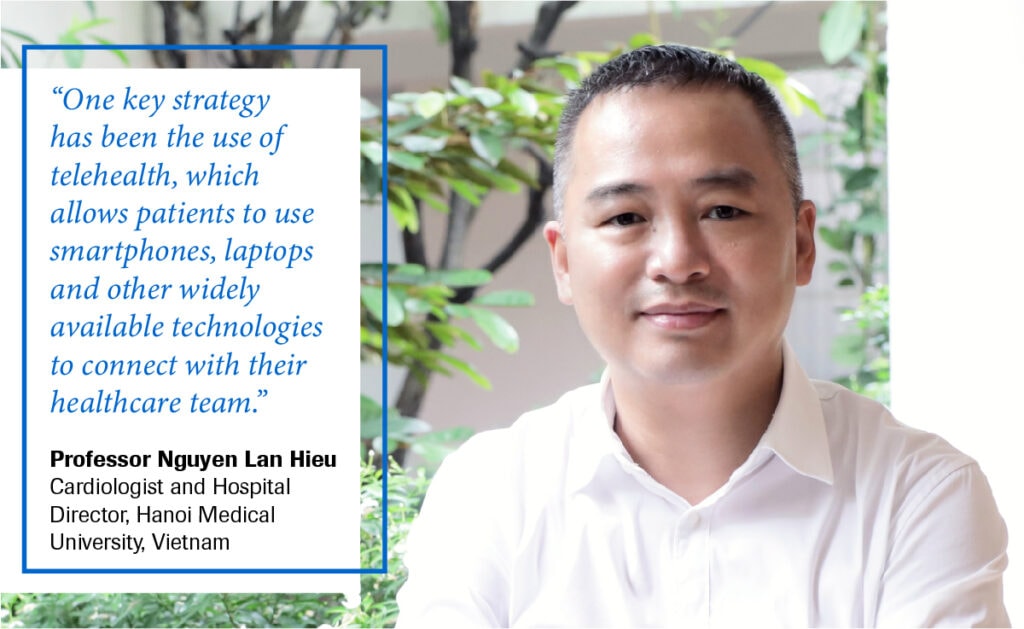A World Health Organization (WHO) survey of NCDs in 155 countries revealed that more than half (53 percent) had partially or completely disrupted services for hypertension treatment; 49 per cent for treatment for diabetes and diabetes-related complications; 42 percent for cancer treatment, and 31 percent for cardiovascular emergencies.1
Furthermore, certain NCDs are believed to increase the severity and the risk of death from COVID-19. At the same time, experts note in a paper published in Aging Clinical and Experimental Research that the virus may also exacerbate pre-existing NCD conditions, and has shown to have more adverse effects on the elderly.2
As the authors summarise it: “the COVID-19 outbreak and related infection control measures could hit the most frail individuals, worsening the condition of NCD patients, while further jeopardising the sustainability of the healthcare systems.”
In short, with a potential spike in NCD cases needing attention soon, clinicians face being overloaded by both infectious and non-infectious cases.
But even as progress in the fight against NCDs faces hurdles, new innovations are being found that can help those at the frontline of healthcare.

Changing Patient Management Protocols
With the pandemic stretching resources in healthcare systems, in some cases it has been impossible to provide both the physical space (treatment facility) and sufficient medical staff to adequately treat existing NCD patients and those with COVID-19.
In Vietnam, for example, where past data shows 77 percent of all deaths were estimated to be caused by NCDs3, Professor Nguyen Lan Hieu, a cardiologist at Medical University Hanoi Hospital, says that in response to the pandemic, the Vietnamese health services made rapid changes to clinical practice in order to keep people safe. Small but significant moves included extending the medication pick-up for patients with chronic NCDs from the usual one month to up to three months; encouraging patients to call the hospital’s hotline to get medical assistance; and issuing medical care guidance to older people and those with underlying medical conditions.
More specifically, he notes, “One key strategy has been the use of telehealth, which allows patients to use smartphones, laptops and other widely available technologies to connect with their healthcare team.”
The other has been providing accessible and quality healthcare services to all people, especially those in remote areas. In Vietnam over 70 percent of people live in rural or remote areas, where they do not enjoy the better-resourced facilities of cities, where most doctors in the country are based. Hanoi and Ho Chi Minh City, for instance, have 38 out of 43 central hospitals, but only 16 percent of the population.4
Read more inspirational medical stories.

Healthcare services across APAC are battling to manage COVID-19 and regular streams of NCD patients at once.
“Through the virtual platform, central hospitals are able to remotely assist district centres in taking care of patients,” Professor Nguyen explains. “For example, leading professors can consult on serious cases, discuss optimal treatment methods and share care experiences with district hospitals. This helps to bridge the gap in medical expertise between central hospitals and district-level hospitals.” The result is not just better quality care, but lower costs and delay in disease progression.
Linking Pandemic and NCD Prevention
As The Lancet states, “Evidence from this and previous pandemics suggests that without proper management, chronic conditions can worsen due to stressful situations resulting from restrictions, insecure economic situations, and changes in normal health behaviours. As with other health service and preventive programmes, the postponement of routine medical appointments and tests can delay NCD management, while physical distancing, restricted access to primary health care units, pharmacies, and community services, alongside a reduction of transport links, all disrupt continuity of care for NCD patients.”5
Professor Nguyen believes medical association and policy makers must work together to develop a response plan — one that takes long-term implications into account. “Our response in the current pandemic and continued focus on the prevention and management of NCDs is interlinked. We cannot compromise one for the other.”
Read more healthcare and diagnostics news at Roche publications.
References:
1 World Health Organization, (2020). COVID-19 Significantly Impacts Health Services for Noncommunicable Diseases. Retrieved from https://www.who.int/news/item/01-06-2020-covid-19-significantly-impacts-health-services-for-noncommunicable-diseases
2 Palmer, K., Monaco, A., Kivipelto, M. et al. (2020). The Potential Long-term Impact of the COVID-19 Outbreak on Patients With Non-communicable Diseases in Europe: Consequences for Healthy Ageing. Aging Clin Exp Res 32, 1189–1194. Retrieved from https://doi.org/10.1007/s40520-020-01601-4
3 World Health Organization (2018). Noncommunicable Diseases (NCD) Country Profiles. Retrieved from https://www.who.int/nmh/countries/vnm_en.pdf?ua=1
4 Nguyet, V.T., (2015). Adoption Of Telemedicine In Vietnam – Case Study Newtel. Thesis, Turku University of Applied Sciences. Retrieved from https://core.ac.uk/download/pdf/38132859.pdf
5 Kluge, H., Wickramasinghe, K., Rippin, H., Mendes, R., et al. (2020). Prevention and Control of Non-communicable Diseases in the COVID-19 Response. The Lancet. Retrieved from https://doi.org/10.1016/S0140-6736(20)31067-9














